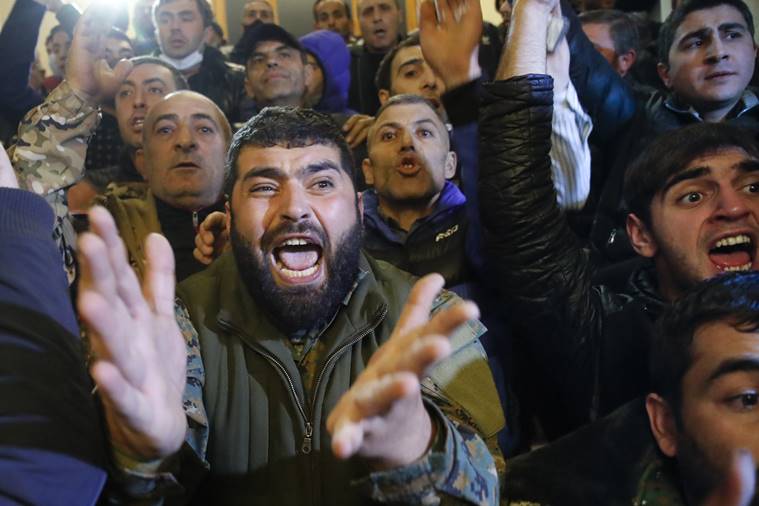
Updated: November 10, 2020 11:21:36 pm
 Azerbaijanis celebrate the peace agreement in Baku on November 10 (Photo: AP)
Azerbaijanis celebrate the peace agreement in Baku on November 10 (Photo: AP)
On Tuesday (November 10), Russia negotiated a new peace agreement between Armenia and Azerbaijan, the two countries that have been in a military conflict for more than six weeks over the disputed Nagorno-Karabakh region in the southern Caucasus.
During the course of the conflict, considered one of the most serious in recent years, more than 1,200 have lost their lives according to the Nagorno-Karabakh authorities, while thousands have been displaced.
The agreement, which is intended to end the conflict between the two nations, was signed by Russian President Vladimir Putin, Azerbaijani President Ilham Aliyev and Armenian Prime Minister Nikol Pashinyan. Since the conflict began in September, multiple ceasefire agreements have been signed between the two sides, but so far none have been successful.
So what is the new peace agreement?
Under the new peace agreement, both sides will now hold positions in the areas they currently occupy, which will mean a significant gain for Azerbaijan as it has regained more than 15-20 percent of its territory lost during the recent conflict, AFP. reported.
Furthermore, under this agreement, all military operations are suspended, Russian peacekeepers will be deployed along the line of contact in Nagorno-Karabakh and along the Lachin corridor that connects the region with Armenia. These Russian peacekeepers with a strength of approximately 2,000 will be deployed in the area over a period of five years.
Refugees and internally displaced persons will return to the region and adjacent territories, and the two sides will also exchange prisoners of war and bodies. Significantly, a new corridor from Nakhchivan to Azerbaijan will be opened, which will be under Russian control.
The BBC reported that a large crowd gathered in the Armenian capital to protest against the peace agreement, while Aliyev of Azerbaijan said the agreement was of “historical importance”.
What are the risks for Russia?
Russia’s role in the conflict has been somewhat opaque as it supplies arms to both countries and is in a military alliance with Armenia called the Collective Security Treaty Organization. In a statement issued last month, Dmitry Peskov, press secretary of the president of the Russian Federation, said that Russia “has always taken a balanced position” on the matter and has “traditionally good relations” with both countries.
What is the Nagorno-Karabakh region?
Straddling Western Asia and Eastern Europe, Nagorno-Karabakh is internationally recognized as part of Azerbaijan, but most of the region is controlled by Armenian separatists. Nagorno-Karabakh has been part of the territory of Azerbaijan since the Soviet era. When the Soviet Union began to collapse in the late 1980s, the Armenian regional parliament voted in favor of transferring the region to Armenia; the Soviet authorities rejected the demand.
Years of fighting between the Azerbaijani forces and the Armenian separatists followed. The violence lasted until the 1990s, leaving tens and thousands dead and displacing hundreds of thousands. In 1994, Russia negotiated a ceasefire, by which time ethnic Armenians had taken control of the region.
 People protest against the terms of the peace agreement at the government building in Yerevan, Armenia, on November 10 (Photo: AP)
People protest against the terms of the peace agreement at the government building in Yerevan, Armenia, on November 10 (Photo: AP)
Although the area remains in Azerbaijan, today it is ruled by separatist Armenians who have declared it a republic called “Nagorno-Karabakh Autonomous Oblast”. While the Armenian government does not recognize Nagorno-Karabakh as independent, it supports the region politically and militarily.
Have there been other ceasefire agreements?
Even after the 1994 peace agreement, the region has been characterized by regular exchanges of fire. In 2016, he saw a Four Day War before Russia brokered peace. The Minsk Group of the Organization for Security and Cooperation in Europe (OSCE), chaired by France, Russia and the US, has been trying to get the two countries to reach a peace agreement for several years.
In October, both countries agreed to a ceasefire agreement, which was also negotiated by Russia but was unsuccessful.
What is the role of ethnicity in the conflict between the two countries?
The ethnic tensions of decades ago play a crucial role in the dispute. While the Azeris claim that the disputed region was under their control in known history, the Armenians hold that Karabakh was part of the Armenian kingdom. At present, the disputed region consists of a predominantly Christian Armenian population, although it is internationally recognized as part of Muslim-majority Azerbaijan.
How did the recent conflict start?
It began on the morning of September 27, since each country has claimed to have inflicted heavy losses on its opponent. What is different about the current outbreak is that this is the first time that both countries have proclaimed martial law.

According to the Warsaw-based Center for Oriental Studies (OSW), the current escalation was “most likely” initiated by Azerbaijan. Media reports have indicated that the clashes were possibly a consequence of Azerbaijan’s attempt to regain some of the territories occupied by Armenian separatists.
The president of the National Council of Azerbaijan said in a statement that “the military operation of the Azerbaijani army continues to clear the territories occupied by the enemy for almost 30 years.” He said that September 27 was a “day of exhaustion” and alleged that Armenia has occupied regions around Nagorno-Karabakh with “direct support” from Russia to create a “security zone”.
© IE Online Media Services Pvt Ltd
.